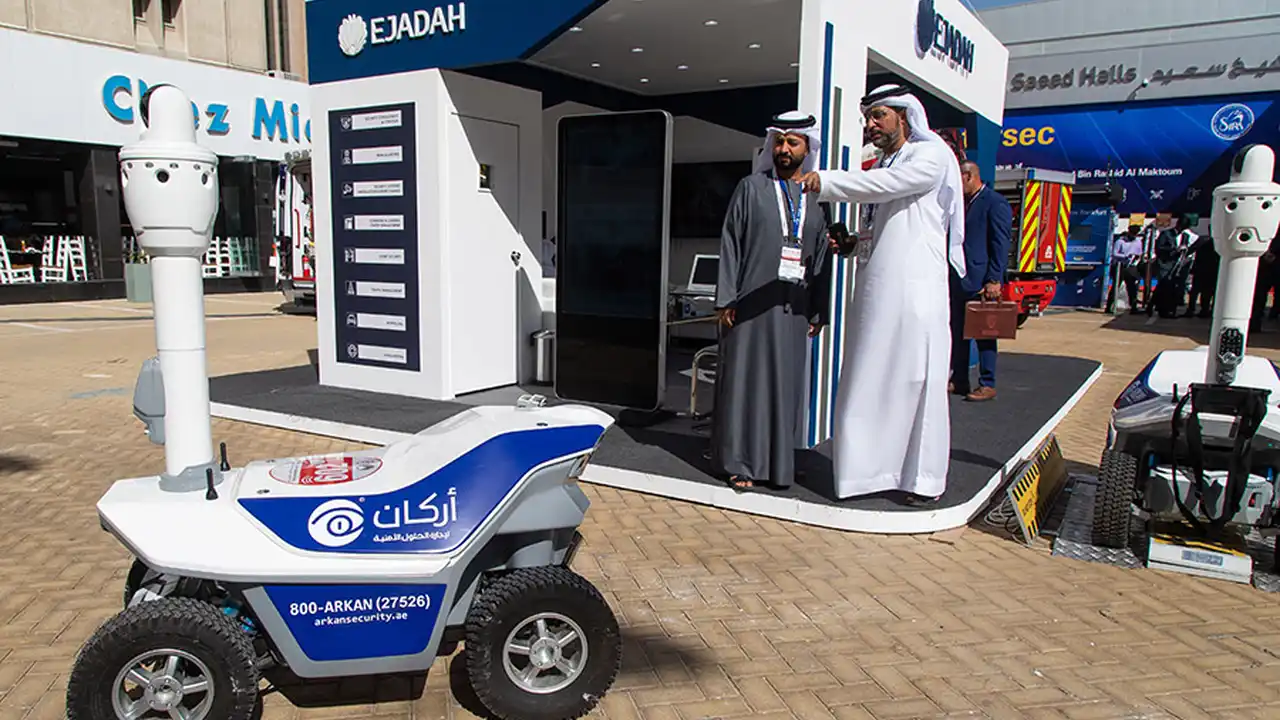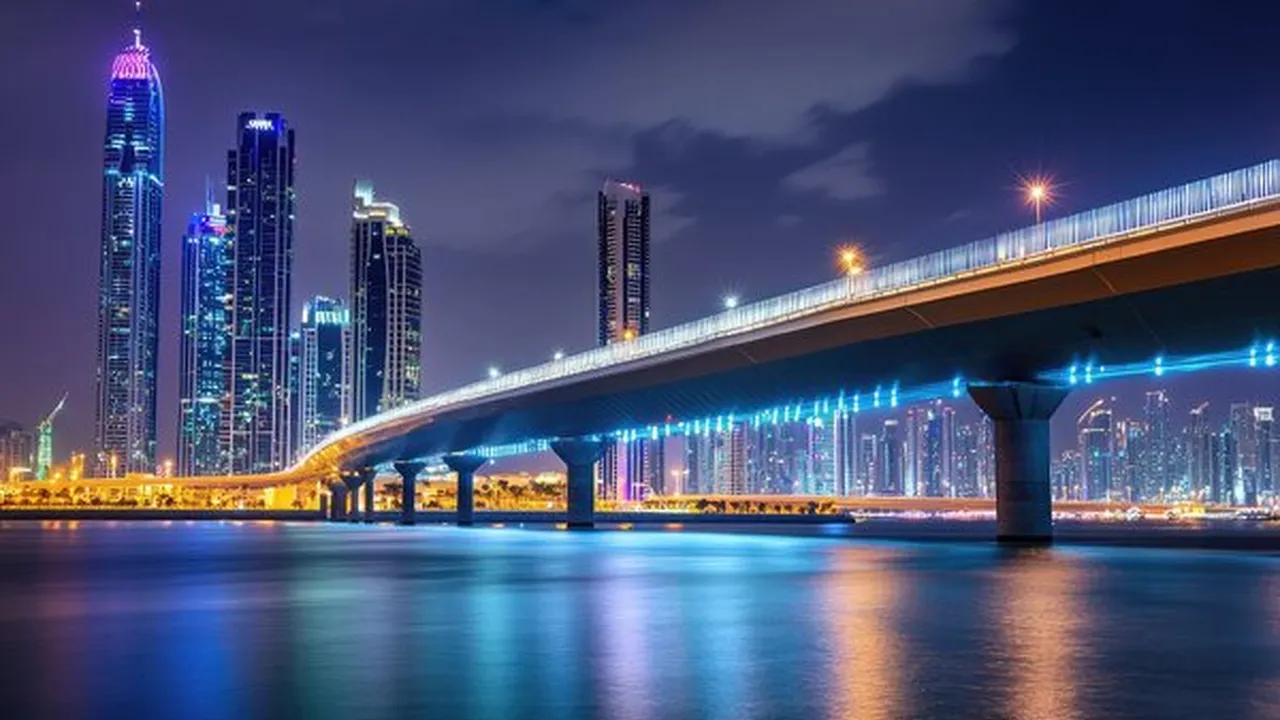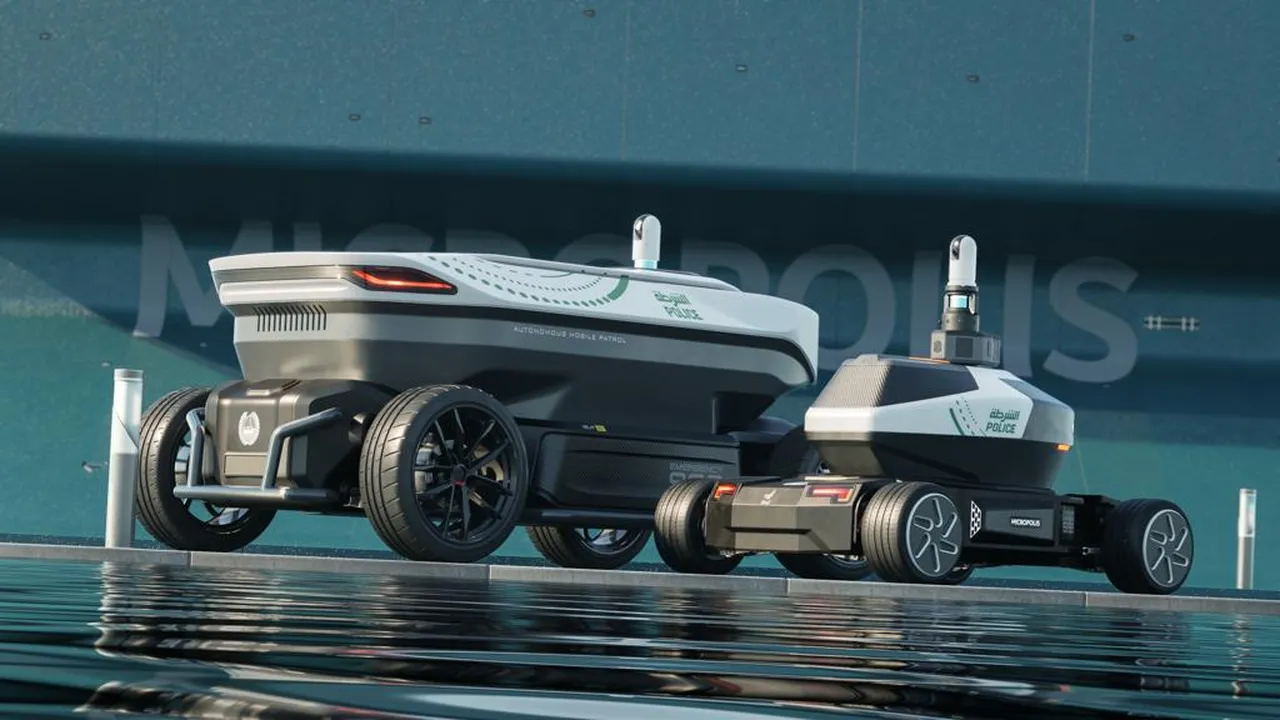How Robots Are Enhancing City Security in Dubai

Robotics in UAE Cities are revolutionizing various sectors, from security to logistics. This article delves into the transformative impact of robotics in urban environments within the United Arab Emirates, exploring specific applications, product recommendations, comparative analyses, and detailed insights.
Robotics in Dubai A New Era of Urban Innovation
Dubai, a city synonymous with innovation and futuristic visions, has wholeheartedly embraced robotics to enhance its urban landscape. The integration of robotic technologies is not merely a novelty but a strategic move to improve efficiency, safety, and the overall quality of life for its residents. From automated cleaning systems to sophisticated surveillance robots, Dubai is at the forefront of robotics adoption in the region.
Robotic Cleaning Systems Maintaining Dubai's Pristine Environment
Maintaining the cleanliness of a bustling metropolis like Dubai is a monumental task. Traditional cleaning methods often fall short in terms of efficiency and resource utilization. This is where robotic cleaning systems come into play. These autonomous machines are designed to navigate complex urban environments, efficiently removing litter, debris, and even pollutants from streets, parks, and public spaces.
One notable example is the use of robotic sweepers equipped with advanced sensors and AI algorithms. These robots can identify and target areas that require immediate attention, optimizing cleaning routes and minimizing energy consumption. They are particularly effective in high-traffic zones such as shopping malls, tourist attractions, and residential areas.
Product Recommendation: The Kärcher MC 50 Mopping Robot is an excellent choice for large-scale cleaning operations. Its robust design, advanced navigation capabilities, and high cleaning performance make it ideal for maintaining the cleanliness of Dubai's expansive urban spaces. Priced around $25,000, it offers a significant return on investment through reduced labor costs and improved cleaning efficiency.
Use Case: The Dubai Municipality has deployed robotic cleaning systems in several key areas, including the Dubai Marina and the Burj Khalifa district. These robots operate around the clock, ensuring that these iconic locations remain clean and inviting for residents and tourists alike.
Robotic Surveillance Enhancing Security and Safety in Dubai
Security is a top priority in Dubai, and robotics plays a crucial role in maintaining a safe and secure environment. Robotic surveillance systems are deployed throughout the city, providing real-time monitoring, threat detection, and rapid response capabilities. These systems are equipped with advanced sensors, cameras, and communication technologies, enabling them to detect suspicious activities, identify potential hazards, and alert security personnel.
One prominent example is the use of autonomous security robots patrolling residential areas and commercial districts. These robots are equipped with facial recognition technology, thermal imaging cameras, and license plate readers, allowing them to identify and track individuals and vehicles of interest. They can also communicate directly with law enforcement agencies, providing them with real-time information and situational awareness.
Product Recommendation: The Knightscope K5 Autonomous Security Robot is a highly effective solution for enhancing security in urban environments. Its robust design, advanced sensor suite, and 360-degree video recording capabilities make it ideal for patrolling large areas and detecting potential threats. The K5 is available through a subscription model, typically costing around $7,000 per month, which includes maintenance and support.
Use Case: Dubai Police has integrated robotic surveillance systems into its security infrastructure, deploying them in high-crime areas and critical infrastructure locations. These robots have proven to be highly effective in deterring crime, detecting suspicious activities, and enhancing overall security.
Robotics in Abu Dhabi A Vision of Sustainable Urban Living
Abu Dhabi, the capital of the UAE, is committed to creating a sustainable and livable urban environment. Robotics plays a key role in achieving this vision, with applications ranging from waste management to smart transportation. The city is investing heavily in robotic technologies to improve efficiency, reduce environmental impact, and enhance the quality of life for its residents.
Robotic Waste Management Optimizing Resource Recovery in Abu Dhabi
Waste management is a significant challenge for any large city, and Abu Dhabi is no exception. Traditional waste collection and processing methods are often inefficient and environmentally damaging. Robotic waste management systems offer a more sustainable and efficient solution, automating the collection, sorting, and recycling of waste materials.
One innovative approach is the use of robotic sorting systems in recycling plants. These systems use advanced sensors and AI algorithms to identify and separate different types of waste materials, such as plastics, metals, and paper. This automated sorting process significantly increases the efficiency of recycling operations, reducing the amount of waste that ends up in landfills.
Product Recommendation: The ZenRobotics Recycler is a cutting-edge robotic sorting system that can automate the separation of various waste materials. Its advanced sensors and AI algorithms enable it to identify and sort materials with high accuracy and speed. The system typically costs around $500,000, but it offers a significant return on investment through increased recycling efficiency and reduced labor costs.
Use Case: The Abu Dhabi Waste Management Centre (Tadweer) is implementing robotic sorting systems in its recycling plants, aiming to increase the recycling rate and reduce the amount of waste sent to landfills. These systems are playing a crucial role in achieving Abu Dhabi's ambitious sustainability goals.
Robotic Transportation Revolutionizing Mobility in Abu Dhabi
Transportation is a critical aspect of urban living, and Abu Dhabi is exploring the use of robotics to revolutionize mobility. Autonomous vehicles, drone delivery systems, and robotic parking solutions are all being considered as ways to improve transportation efficiency, reduce congestion, and enhance the overall commuting experience.
One promising area is the development of autonomous vehicles for public transportation. These vehicles can operate without human drivers, providing a safe and efficient means of transportation for residents and visitors. They can also be integrated with smart traffic management systems, optimizing routes and reducing congestion.
Product Recommendation: The Navya Arma Autonomous Shuttle is a commercially available autonomous vehicle that can be deployed for public transportation in urban environments. Its compact design, advanced sensors, and autonomous driving capabilities make it ideal for navigating complex city streets. The Arma typically costs around $300,000 and can be customized to meet specific transportation needs.
Use Case: The Integrated Transport Centre (ITC) in Abu Dhabi is conducting trials of autonomous vehicles on designated routes, evaluating their performance and suitability for integration into the city's public transportation network. These trials are paving the way for the widespread adoption of autonomous vehicles in Abu Dhabi.
Robotics in Sharjah Enhancing Industrial Efficiency and Logistics
Sharjah, known for its industrial prowess, is leveraging robotics to enhance efficiency and optimize logistics operations. The emirate is focused on adopting robotic solutions that can streamline manufacturing processes, improve warehouse management, and enhance supply chain efficiency. This strategic adoption of robotics is aimed at boosting Sharjah's competitiveness in the global market.
Robotic Manufacturing Automating Production Processes in Sharjah
Manufacturing is a key sector in Sharjah, and robotics is playing a crucial role in automating production processes. Robotic arms, automated guided vehicles (AGVs), and other robotic systems are being deployed in factories to improve efficiency, reduce costs, and enhance product quality. These robotic solutions can perform a wide range of tasks, from welding and assembly to painting and packaging.
One significant application is the use of robotic arms in assembly lines. These robots can perform repetitive tasks with high precision and speed, reducing the risk of errors and increasing overall productivity. They can also be easily programmed to adapt to changing production requirements.
Product Recommendation: The ABB IRB 1200 Industrial Robot is a versatile and reliable robotic arm that can be used for a wide range of manufacturing applications. Its compact design, high precision, and advanced control system make it ideal for automating assembly lines and other production processes. The IRB 1200 typically costs around $50,000 and offers a significant return on investment through increased productivity and reduced labor costs.
Use Case: Several manufacturing companies in Sharjah have adopted robotic arms to automate their production processes, resulting in significant improvements in efficiency, quality, and cost-effectiveness. These companies are experiencing the benefits of robotics firsthand and are expanding their use of robotic technologies.
Robotic Logistics Optimizing Warehouse Management in Sharjah
Logistics is another critical sector in Sharjah, and robotics is being used to optimize warehouse management and improve supply chain efficiency. Automated storage and retrieval systems (AS/RS), robotic forklifts, and other robotic solutions are being deployed in warehouses to streamline operations, reduce costs, and improve accuracy.
One innovative approach is the use of drone delivery systems for last-mile delivery. These drones can transport packages quickly and efficiently, reducing delivery times and improving customer satisfaction. They are particularly useful for delivering goods in congested urban areas.
Product Recommendation: The Fetch Robotics Freight500 Autonomous Mobile Robot is a highly effective solution for automating warehouse operations. Its robust design, advanced navigation capabilities, and high payload capacity make it ideal for transporting goods within warehouses and distribution centers. The Freight500 is available through a subscription model, typically costing around $3,000 per month, which includes maintenance and support.
Use Case: Several logistics companies in Sharjah are experimenting with drone delivery systems, aiming to reduce delivery times and improve customer service. These companies are exploring the potential of drone delivery to revolutionize the last-mile delivery process.
Robotics Product Comparison A Detailed Analysis
Choosing the right robotic solution for a specific application can be a complex task. A detailed comparison of different products is essential to ensure that the chosen solution meets the specific needs and requirements of the user. Here's a comparison of some of the robotic products mentioned earlier:
Kärcher MC 50 Mopping Robot vs Brain Corp BrainOS-Powered Scrubbers
Both the Kärcher MC 50 and Brain Corp BrainOS-powered scrubbers are designed for large-scale cleaning operations. However, they differ in their features and capabilities. The Kärcher MC 50 is a robust and reliable machine that offers high cleaning performance. It is ideal for maintaining the cleanliness of expansive urban spaces. BrainOS-powered scrubbers, on the other hand, offer advanced autonomous navigation and data analytics capabilities. They can be integrated with cloud-based platforms to track cleaning performance and optimize cleaning routes. BrainOS is not a specific robot, but rather an operating system that powers various cleaning robots from different manufacturers. The cost varies depending on the specific robot and BrainOS subscription.
Key Differences: The Kärcher MC 50 is a dedicated cleaning robot, while BrainOS is an operating system that powers various cleaning robots. BrainOS offers advanced autonomous navigation and data analytics capabilities, while the Kärcher MC 50 focuses on robust cleaning performance.
Knightscope K5 vs Cobalt Robotics Security Robots
Both the Knightscope K5 and Cobalt Robotics security robots are designed to enhance security in urban environments. However, they differ in their design, features, and capabilities. The Knightscope K5 is a large, conspicuous robot that is designed to deter crime through its presence. It is equipped with a 360-degree video recording system, thermal imaging cameras, and license plate readers. Cobalt Robotics security robots, on the other hand, are smaller and more agile. They are equipped with a suite of sensors, including cameras, microphones, and environmental sensors, and are monitored by remote security specialists.
Key Differences: The Knightscope K5 is a larger, more conspicuous robot, while Cobalt Robotics security robots are smaller and more agile. Cobalt Robotics security robots are monitored by remote security specialists, while the Knightscope K5 operates autonomously.
ZenRobotics Recycler vs AMP Robotics Sorting Systems
Both the ZenRobotics Recycler and AMP Robotics sorting systems are designed to automate the separation of waste materials in recycling plants. However, they differ in their technology and approach. The ZenRobotics Recycler uses robotic arms equipped with advanced sensors and AI algorithms to identify and sort materials. AMP Robotics sorting systems use computer vision and machine learning to identify and sort materials. AMP Robotics also utilizes robotic arms, but their core technology is centered around their AI-powered vision system.
Key Differences: The ZenRobotics Recycler uses robotic arms with advanced sensors and AI algorithms, while AMP Robotics sorting systems use computer vision and machine learning. AMP Robotics is generally considered to be more focused on speed and accuracy due to its advanced AI.
Navya Arma vs EasyMile EZ10 Autonomous Shuttles
Both the Navya Arma and EasyMile EZ10 are commercially available autonomous shuttles that can be deployed for public transportation in urban environments. They are similar in size and capabilities, offering a safe and efficient means of transportation for residents and visitors. However, they differ in their design and features. The Navya Arma has a more modern and streamlined design, while the EasyMile EZ10 has a more traditional shuttle bus design. Both are limited in speed and are best suited for controlled environments or designated routes.
Key Differences: The Navya Arma has a more modern and streamlined design, while the EasyMile EZ10 has a more traditional shuttle bus design. Performance differences are minimal and often depend on the specific software and sensors installed.
ABB IRB 1200 vs Universal Robots UR5e Industrial Robots
Both the ABB IRB 1200 and Universal Robots UR5e are versatile and reliable robotic arms that can be used for a wide range of manufacturing applications. However, they differ in their size, payload capacity, and ease of programming. The ABB IRB 1200 is a larger and more powerful robot, capable of handling heavier payloads. The Universal Robots UR5e is a smaller and more collaborative robot, designed to work alongside human workers. Universal Robots are known for their ease of programming and user-friendly interface.
Key Differences: The ABB IRB 1200 is a larger and more powerful robot, while the Universal Robots UR5e is smaller and more collaborative. Universal Robots are easier to program and are designed for collaborative work environments.
Fetch Robotics Freight500 vs Locus Robotics Autonomous Mobile Robots
Both the Fetch Robotics Freight500 and Locus Robotics autonomous mobile robots are designed to automate warehouse operations. However, they differ in their approach and capabilities. The Fetch Robotics Freight500 is a versatile AMR that can be used for a wide range of tasks, including transporting goods, picking orders, and replenishing shelves. Locus Robotics AMRs are designed specifically for order fulfillment and are typically used in conjunction with human pickers. Locus robots guide pickers to the correct locations and transport the picked items to packing stations.
Key Differences: The Fetch Robotics Freight500 is a more versatile AMR, while Locus Robotics AMRs are designed specifically for order fulfillment. Locus Robotics utilizes a collaborative approach with human pickers, while Fetch Robotics can operate more independently.
Robotics Pricing Considerations A Detailed Breakdown
The cost of robotic solutions can vary significantly depending on the type of robot, its features, and the specific application. It's important to consider all the costs associated with robotic solutions, including the initial purchase price, installation costs, maintenance costs, and operating costs. Here's a breakdown of the pricing considerations for some of the robotic products mentioned earlier:
Initial Purchase Price
The initial purchase price is the most obvious cost associated with robotic solutions. This can range from a few thousand dollars for small collaborative robots to several hundred thousand dollars for large industrial robots. It's important to compare the prices of different products and consider the features and capabilities offered at each price point.
Installation Costs
Installation costs can also be significant, especially for large and complex robotic systems. These costs can include the cost of preparing the site, installing the robot, and integrating it with existing systems. It's important to factor in these costs when budgeting for robotic solutions.
Maintenance Costs
Maintenance costs are an ongoing expense that should be considered when evaluating robotic solutions. These costs can include the cost of routine maintenance, repairs, and replacement parts. It's important to choose a robot that is reliable and easy to maintain.
Operating Costs
Operating costs can also be significant, especially for robots that consume a lot of energy or require specialized materials. These costs can include the cost of electricity, compressed air, and other consumables. It's important to choose a robot that is energy-efficient and uses readily available materials.
Subscription Models
Some robotic solutions are offered through subscription models, where users pay a monthly or annual fee for access to the robot and its services. This can be a more affordable option for small businesses or organizations that don't want to invest in the upfront cost of purchasing a robot. Subscription models typically include maintenance and support, which can further reduce costs.
The Future of Robotics in UAE Cities
The future of robotics in UAE cities is bright. As technology continues to advance and costs continue to decline, we can expect to see even more widespread adoption of robotic solutions in various sectors. From autonomous vehicles to personalized healthcare robots, robotics has the potential to transform urban living in the UAE and beyond.
One key trend to watch is the development of more collaborative robots, also known as cobots. These robots are designed to work alongside human workers, assisting them with tasks that are too dangerous, repetitive, or physically demanding. Cobots have the potential to improve productivity, reduce injuries, and create new job opportunities.
Another important trend is the development of more intelligent robots that can learn and adapt to changing conditions. These robots are equipped with advanced sensors, AI algorithms, and machine learning capabilities, allowing them to make decisions and solve problems autonomously. Intelligent robots have the potential to automate complex tasks and improve efficiency in a wide range of industries.
UAE cities are well-positioned to lead the way in the adoption of robotics. With their strong economies, supportive governments, and forward-thinking leaders, these cities are creating an environment that is conducive to innovation and technological advancement. As robotics continues to evolve, we can expect to see UAE cities at the forefront of this exciting revolution.
:max_bytes(150000):strip_icc()/277019-baked-pork-chops-with-cream-of-mushroom-soup-DDMFS-beauty-4x3-BG-7505-5762b731cf30447d9cbbbbbf387beafa.jpg)






